Military occupations by the Soviet Union
| World War II |
|---|
| Alphabetical indices |
| 0-9 A B C D E F G H I J K L M N O P Q R S T U V W X Y Z |
| Navigation |
| Timelines of World War II |
|---|
| Chronological |
| Before (Asia · Europe) |
| Topical |
The article lists military occupations by the Soviet Union from the prelude to the aftermath of World War II[1][2][3] and subsequent Cold War.
World War II
During the period of the Molotov-Ribbentrop pact

During World War II, the Soviet Union occupied and annexed several countries effectively ceded to it by Nazi Germany in the Molotov-Ribbentrop Pact's secret protocol. These included Eastern Poland (incorporated into two different SSRs),[4] Latvia (became Latvian SSR),[5][6] Estonia (became Estonian SSR),[5][6] Lithuania (became Lithuanian SSR),[5][6] part of eastern Finland (became Karelo-Finnish SSR)[7] and eastern Romania (became the Moldavian SSR).[8][9]
Poland (1939–1956)
Poland was the first country to be occupied by Soviet Union during the World War II era.
The secret protocol of the Molotov-Ribbentrop pact stipulated Poland to be split between Soviet Union and Nazi Germany.[10] In 1939, the total area of Polish territories occupied by the Soviet Union (including the area given to Lithuania and annexed in 1940 during the formation of Lithuanian SSR), was 201,015 square kilometres, with a population of 13.299 million, of which 5.274 million were ethnic Poles and 1.109 million were Jews.[11]
After the end of World War II, the Soviet Union kept most of the territories it occupied in 1939, while territories with an area of 21,275 square kilometers with 1.5 million inhabitants were returned to communist-controlled Poland, notably the areas near Białystok and Przemyśl.[12] In 1944–1947, over a million Poles were resettled from the annexed territories into Poland (mostly into the Regained Territories).[13]
Soviet troops (the Northern Group of Forces) were stationed in Poland from 1945 till 1993. It was only in 1956 that official agreements between communist regime in Poland established by Soviets themselves and Soviet Union recognized the presence of those troops; hence many Polish scholars accept the usage of term 'occupation' for period 1945–1956.[14] Other scholars date the Soviet occupation till 1989.[15][16] The Polish Government in Exile existed until 1990.
Baltic states (1940–1991)
After existing as independent countries for twenty years, the Baltic states were occupied and illegally annexed in June 1940.[17] Given a free hand by Nazi Germany via the German-Soviet Nonaggression Pact and its secret additional protocol of August 1939,[18] the Soviet Union pressured the three countries to accept its military bases in September 1939. In the case of refusal, the USSR effected an air and naval blockade and threatened to attack immediately with hundreds of thousands of troops massed upon the border. The military forces overtook the political systems of these countries and installed puppet regimes after rigged elections in June 1940.[19]
The sovietisation was interrupted by the German occupation in 1941–1944. The Baltic Offensive re-established the Soviet control in 1944–1945, and resumed sovietisation, mostly completed by 1950. The forced collectivisation of agriculture began in 1947, and was completed after the mass deportation in March 1949. Private farms were confiscated, and farmers were made to join the collective farms. An armed resistance movement of 'forest brothers' was active until the mid-1950s. Hundreds of thousands participated or supported the movement; tens of thousands were killed. The Soviet authorities fighting the forest brothers also suffered hundreds of deaths. Some innocent civilians were killed on both sides. In addition, a number of underground nationalist schoolchildren groups were active. Most of their members were sentenced to long terms of imprisonment. The punitive actions decreased rapidly after Joseph Stalin's death in 1953; from 1956–58, a large part of the deportees and political prisoners were allowed to return.[19]
During the occupation, the Soviet authorities killed, politically arrested, unlawfully drafted, and deported hundreds of thousands of people. Numerous other kind of crimes against humanity were committed all through the occupation period.[19] Furthermore, trying to enforce the ideals of Communism, the authorities deliberately dismantled the existing social and economic structures, and imposed new "ideologically pure" hierarchies. This severely retarded the Baltic economies. For example, Estonian scientists have estimated economic damages directly attributable to the post-World War II occupation to hundreds of billions of US dollars (several dozens worth of Estonia's 2006 GDP of $21.28 billion[20]). The Soviet environmental damage to Estonia is estimated to about $4 billion. In addition to direct damages, the retarded economy led to severe inequality within the Northern Europe.
After all, the attempt to integrate the Estonian society into the Soviet system failed. Although the armed resistance was defeated, the population remained anti-Soviet. This helped the Estonians to organise a new resistance movement in the late 1980s, regain their independence in 1991, and then rapidly develop a modern society.[19]
Notwithstanding the annexation by the Soviet Union in 1940, it is therefore correct to speak of the occupation of the Baltic states, referring in particular to the absence of Soviet legal title. The prolonged occupation was an unorthodox one. Until 1991, the status of the three countries resembled the classical occupation in important ways: external control by an internationally unsanctioned force and a conflict of interest between the foreign power and the inhabitants. However, in other aspects the situation was very different from a classical occupation. Both the fact of the incorporation of the Baltic states to the USSR as Soviet republics without qualification, and the long duration of the Soviet rule challenge the applicability of all rules on occupation from the practical point of view. Despite the fact of annexation, the presence of the USSR in the Baltic states remained an occupation sui generis.[21]
Although the Soviet Union condemned the Molotov-Ribbentrop Pact[22][23] — the immediate forerunner to the occupation — it is currently the policy of the USSR's legal successor Russian Federation to deny that the events constituted occupation or were illegal under applicable (international) laws.[24]
Finnish territories (1940)
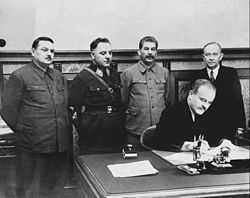
The Soviet Union demanded to move the Finnish border further away from Leningrad. The USSR also insisted that Finland lease the Hanko Peninsula (or similar territory at the entrance to the Gulf of Finland) for the creation of a Red Baltic Fleet naval base.[25] However, Finland refused and the Soviet Union invaded the country, initiating the Winter War. The USSR set up the Finnish Democratic Republic (Finnish: Suomen kansanvaltainen tasavalta), a short-lived Soviet puppet regime in the occupied Karelian territories. The Soviets also occupied the Petsamo municipality in the Barents Sea coast during the war. The Moscow Peace Treaty ended the state of occupation on 12 March 1940, as Finland was forced to cede parts of Karelia. The land accounted for 9% of the country's territory, included Finland's second largest city Viipuri and much of Finland's industry. About 422,000 Karelians — 12% of Finland's population — choose rather to evacuate beyond the new border and lose their homes than to become Soviet subjects. The military troops and the remaining civilians were hastily evacuated. Finland also had to cede a part of the Salla area, the Kalastajansaarento peninsula in the Barents Sea and four islands in the Gulf of Finland. The ceded areas were integrated within the Karelian ASSR to form the Karelo-Finnish SSR.
When the hostilities resumed in 1941, Finnish forces retook the lost areas and then advanced further up to the Svir River and Lake Onega before the end of the year. In the Soviet offensive of 1944 against the Finns the Red Army advance was halted by the Finns before reaching the 1940 border or, in the sole case where it did happen, the Red Army was promptly thrown back in Finnish counterattack. In the negotiations that followed the stopping of the Soviet offensive Finns further ceded the Petsamo municipality to the Soviet Union in the Moscow Armistice. The Soviet forces took the municipality from the Germans during the Petsamo–Kirkenes Offensive.
Bessarabia and Northern Bukovina (1940)
The Soviet Union, which did not recognize the sovereignty of Romania over Bessarabia since the union of 1918, issued an ultimatum on 28 June 1940 demanding the evacuation of the Romanian military and administration from the territory it contested as well as from the northern part of the Romanian province of Bukovina.[26] Under pressure from Moscow and Berlin, the Romanian administration and armed forces retreated to avoid war. Adolf Hitler used Soviet occupation of Bessarabia as justification for German occupation of Yugoslavia and Greece and German attack on USSR.
After the USSR entered the war on the Allied side
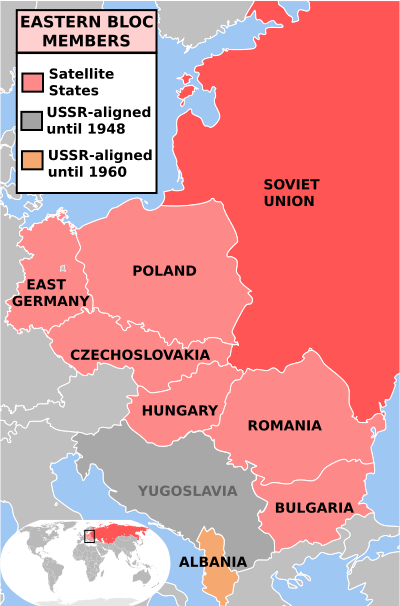
On 22 June 1941, the Operation Barbarossa commenced, which gave a start of the Eastern front. German lead European Axis countries and Finland invaded the USSR, thereby terminating the German-Soviet non-aggression treaty. During the hostilities between the Soviet Union and the Axis, which led to the total military defeat of the latter, the USSR fully or partially occupied the territory of Germany and its satellites, as well as the territories of some Germany occupied states and Austria. Some of them became Soviet Satellite states, namely, the People's Republic of Poland, the People's Republic of Hungary,[27] the Czechoslovak Socialist Republic,[28] the Romanian People's Republic, the People's Republic of Bulgaria, the People's Republic of Albania;[29] later, East Germany was formed based on the Soviet zone of German occupation.[30]
Northern Iran 1941–1946
On 25 August 1941 British and Commonwealth forces and the Soviet Union jointly invaded Iran. The purpose of the invasion (codenamed Operation Countenance) was to secure Iranian oil fields and ensure supply lines (see Persian Corridor) for the Soviets fighting against European Axis countries on the Eastern Front.
Hungary (1944)
In July 1941, the Kingdom of Hungary, a member of the Tripartite Pact, took part in Operation Barbarossa, in alliance with Nazi Germany. Hungarian forces fought shoulder to shoulder with the Wehrmacht and advanced through the Ukrainian SSR deep into Russia, all the way to Stalingrad. However, by the end of 1942 the Soviet Red Army began pushing back the Wehrmacht through a series of offensives that preceded the Red Army's encroachment upon Hungarian territory in 1943–44. In September 1944 Soviet forces crossed into Hungary, launching the Budapest Offensive. As the Hungarian army ignored the armistice with the USSR signed by the government of Miklós Horthy on 15 October 1944, the Soviets fought their way further westward against the Hungarian troops and their Nazi allies capturing the capital on 13 February 1945. Operations continued until 4 April 1945, when the last Nazi forces and the remaining Hungarian troops loyal to the Germans were routed out of the country.
The Soviets made sure that a loyal post-war government dominated by Communists was installed in the country before transferring authority from the occupational force to the Hungarian authorities. The presence of Soviet troops in the country was regulated by the 1949 mutual assistance treaty concluded between the Soviet and Hungarian governments. The Hungarian Revolution of 1956 was a spontaneous nationwide revolt against the Communist government of Hungary and its Soviet-imposed policies. After announcing a willingness to negotiate the withdrawal of Soviet forces, the Soviet Politburo changed its mind. On 4 November 1956, a large joint military force of the Warsaw Pact led by Moscow, entered Budapest to crush the armed resistance, killing thousands of civilians in the process.
After the collapse of the Soviet Union, the last Soviet soldier left the country in 1991, thus ending Soviet military presence in Hungary.
Romania (1944)
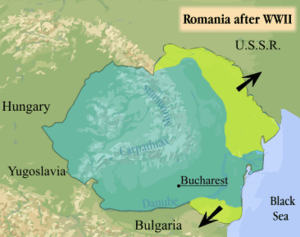
Soviet Jassy-Kishinev Offensive led to defeat of Romania, subsequent coup d'état, and the switch of Romania from the Axis to the Allies. The Soviet troops were stationed in this country from 1944 and 1958.[31] On 12 September 1944, with the Red Army already controlling much of Romania's territory, an Armistice Agreement between Romania and the USSR was signed, under which Romania retroceded the territory it administered earlier in the war, and subjected itself to an allied commission consisting of the Soviet Union, the United States, and the United Kingdom. On the ground, it was the Soviet military command, and not the Western allies, that de facto exercised dominant authority. The presence and free movement of Soviet troops was explicitly stipulated in the agreement.[32]
The terms of the Armistice Agreement ceased on 15 September 1947 as the conditions of the Paris Peace Treaty entered into force. The new treaty stipulated the withdrawal of all Allied forces from Romania with an important exemption that such withdrawal was "subject to the right of the Soviet Union to keep on Romanian territory such armed forces as it may need for the maintenance of the lines of communication of the Soviet Army with the Soviet zone of occupation in Austria."
In the aftermath of the agreement the Soviet presence fell from 130,000 troops (the peak in 1947) to approximately 30,000. The troops were fully withdrawn by August 1958.
Comparing the Soviet occupation of Romania to that of Bulgaria, David Stone notes: "Unlike Bulgaria, Romania had few cultural and historical ties with Russia, and had actually waged war on the Soviet Union. As a result, Soviet occupation weighted heavier on the Romanian people, and the troops themselves were less disciplined."[33]
Bulgaria (1944)
On 5 September 1944, the Soviet Union declared war on Bulgaria and on 8 September invaded the country, without encountering resistance. By the next day Soviets occupied the northeastern part of Bulgaria along with the key port city of Varna. On 8 September 1944 Bulgaria declared war against Nazi Germany. Garrison detachments with Zveno officers at the head overthrew the government on the eve of 9 September, after taking strategic keypoints in Sofia and arresting the ministers. A new government of the Fatherland Front was appointed on 9 September with Kimon Georgiev as prime minister. Soviet troops were withdrawn in 1947[34]
Czechoslovakia (1944)
Following the capture of Prague by the Red Army in May 1945 the Soviets withdrew in December 1945 as part of an agreement that all Soviet and US troops leave the country.
Northern Norway 1944–1946 / Bornholm 1945–1946
1944–1946, Soviet troops occupied northern Norway and the Danish island of Bornholm, strategically situated at the Baltic sea entrance. Stalin's intent was to attempt to gain bases at these locations late in the war.[35] The Soviet deputy ambassador suggested seizing Bornholm in March 1945 and on May 4 the Baltic Fleet was ordered to seize the island.[35]
Bornholm was heavily bombarded by Soviet forces in May 1945. Gerhard von Kamptz, the German superior officer in charge failed to provide a written capitulation as demanded by the Soviet commanders, several Soviet aircraft relentlessly bombed and destroyed more than 800 civilian houses in Rønne and Nexø and seriously damaged roughly 3000 more during 7 – 8 May 1945. On 9 May, Soviet troops landed on the island and after a short fight the German garrison did surrender.[36] Soviet forces left the island on 5 April 1946.
Germany (1945)
Soviet occupation zone of Germany was the area of eastern Germany occupied by the Soviet Union from 1945 on. In 1949 it became The German Democratic Republic known in English as East Germany.
In 1955 the Republic was declared by the Soviet Union to be fully sovereign; however, Soviet troops remained, based on the four-power Potsdam agreement. As NATO troops remained in West Berlin and West Germany, the GDR and Berlin in particular became focal points of Cold War tensions.
A separation barrier between West and East Germany, the Berlin Wall known in the Soviet Union and in East Germany as the "Anti-Fascist Protective Rampart,"[37] was built in 1961.
The Treaty on the Final Settlement With Respect to Germany signed in Moscow, mandated the withdrawal of all Soviet forces from Germany by the end of 1994. Conclusion of the final settlement cleared the way for unification of East and West Germany. Formal political union occurred on 3 October 1990.
One result of the occupation was children fathered by Russian soldiers either through romantic relationships, relationships of convenience or rape. These children experience societal discrimination for decades but after the troops withdrawal and the development of perestroika, some of these "Lost Red Army Children" made public attempts to discover more about their Russian fathers.[38]
Austria 1945–1955
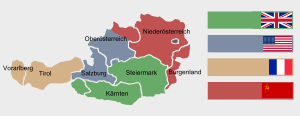
The Soviet occupation of Austria, 1945–1955.[39] At the end of the war, Austria and Vienna were divided into 4 zones of occupation, following the terms of the Potsdam Conference. The country was earmarked for heavy economic exploitation. The Soviet Union expropriated over 450 businesses, formerly German-owned.
On 15 May 1955, the Austrian State Treaty was signed, officially establishing Austrian independence and sovereignty. The treaty was enacted on 27 July, and the last Allied troops left the country on 25 October.
Manchuria 1945–1946
The Soviet invasion of Manchuria or, as the Soviets named it, the Manchurian Strategic Offensive Operation (Манчжурская стратегическая наступательная операция, lit. Manchzhurskaya Strategicheskaya Nastupatelnaya Operaciya), began on August 9, 1945, with the Soviet invasion of the Japanese puppet state of Manchukuo and was the largest campaign of the 1945 Soviet–Japanese War which resumed hostilities between Soviet Union and the Empire of Japan after more than 4 years of peace. Soviets gains on the continent were Manchukuo, Mengjiang (Inner Mongolia) and northern Korean Peninsula. The rapid defeat of Japan's Kwantung Army was a very significant factor in the Japanese surrender and the end of World War II, as Japan realized the Russians were willing and able to take the cost of invasion of its Home Islands, after their rapid conquest of Manchuria and southern Sakhalin.[40][41][42][43][44]
Korea 1945–1948
In August 1945 the Soviet Army established the Soviet Civil Authority to administer the country until a domestic regime could be established. Provisional committees were set up across the country putting Communists into key positions. In February 1946 a provisional government called the North Korean Provisional People's Committee was formed under Kim Il-sung. Soviet forces departed in 1948, and a few years later, in an attempt to unite Korea under Communist rule, the Korean War broke out.
Kuril Islands 1945
After Japan accepted the Potsdam Declaration on August 14, 1945, and announced the termination of the war on August 15, 1945, that the Soviet Union started the Invasion of the Kuril Islands, which took place between August 18 and September 3, expelling the Japanese inhabitants two years later[45]
Cold War
Czechoslovakia (1968–1991)
In 1948, the Czech Communist Party won a large portion of the vote in Czechoslovak politics, leading to a communist period without immediate Soviet military presence. The 1950s were characterized as a repressive period in the country's history, but by 1960s, the local socialist leadership had taken a course toward toward economic, social and political reforms. However, a number of significant Czech communists, together with the Czech security agency, conspired against limited introduction of market systems, personal freedoms, and renewal of civic associations (see Socialism with a human face) by leveraging Russian support towards strengthening Communist Party's positions.[46]
Leonid Brezhnev, General Secretary of the Communist Party of the Soviet Union, reacted to these reforms by announcing the Brezhnev Doctrine, and in 21 August 1968, about 750,000 Warsaw Pact troops, mostly from the Soviet Union, Poland, Bulgaria and Hungary, with tanks and machine guns occupied Czechoslovakia, deported thousands of people and rapidly derailed all reforms. Most large cities were individually invaded and overtaken; however, the invasion's primary attention focused on Prague, particularly the state organs, Czech television and radio.
The Czechoslovak government held an emergency session, and loudly expressed its disagreement with the occupation. Many citizens joined in protests, and by September 1968 at least 72 people had died and hundreds more injured in the conflicts. In the brief time after the occupation, which had put an end to any hope that Prague Spring had created, about 100,000 people fled Czechoslovakia. Over the whole time of the occupation, more than 700,000 people, including significant part of Czechoslovak intelligentsia left. Communists responded by revoking Czechoslovakian citizenship of many of these refugees and banned them from returning to their homeland.
At a meeting of the United Nations Security Council, Yakov Malik, Soviet ambassador to the United Nations issued a proclamation, claiming that the military intervention was a response to a request by the government of Czechoslovakia. The Soviet Union being a permanent member of the Security Council — with veto right —, was able to circumvent any United Nations' resolutions to end the occupation.
Prague Spring's end became clear by December 1968, when a new presidium of the Communist Party of Czechoslovakia accepted the so-called Instructions from The Critical Development in the Country and Society after the XIII Congress of the Communist Party of Czechoslovakia. Under a guise of "normalisation", all aspects of neo-Stalinism were returned to everyday political and economic life.
Soviet occupation of Czechoslovakia ended only in 1991, just before the collapse of Soviet Union. The last occupation troops left the country on 27 June 1991[47]
In 1987, the Soviet leader Mikhail Gorbachev acknowledged that his liberalizing policies of glasnost and perestroika owed a great deal to Dubček's socialism with a human face. When asked what the difference was between the Prague Spring and his own reforms, Gorbachev replied, "Nineteen years".
Vladimir Putin said that he feels the moral responsibility for the 1968 events and that Russia condemns them during his visit to Prague.[48]
Afghanistan 1979–1989
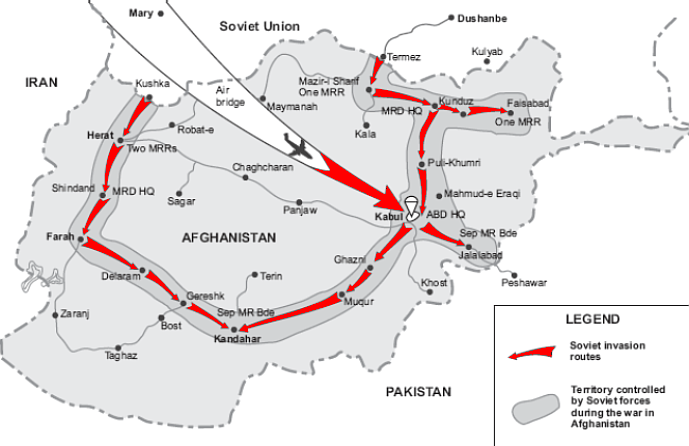
Scholarly and historical accounts maintained that Afghanistan had been under Soviet Union's influence early as 1919 when Afghanistan had receiving aid to counter the Anglosphere of the United Kingdom. Major Soviet technical assistance, military aid, and economic relations grew in 1950s followed up by the Communist Revolution in Afghanistan in 1970s. The threat of fall of communism in Afghanistan invited Soviet Union's invasion of Afghanistan which began as midnight approached on 24 December 1979. They organised a massive military airlift into Kabul, involving an estimated 280 transport aircraft and 3 divisions of almost 8,500 men each. Within two days, Soviet Union had seized the control of Afghanistan, first securing Kabul, deploying a special Soviet assault unit against Darulaman Palace, where elements of the Afghan army loyal to Hafizullah Amin put up a fierce, but brief resistance. With Amin's death at the palace, Babrak Karmal, exiled leader of the Parcham faction of the PDPA was installed by the Soviets as Afghanistan's new head of government.[49]
The peak of the fighting came in 1985–86. The Soviet forces launched their largest and most effective assaults on the mujahedin supply lines adjacent to Pakistan. Major campaigns had also forced the mujahedin into the defensive near Herat and Kandahar. On 15 February 1989, the last Soviet troops departed on schedule from Afghanistan.
See also
- Military history of the Soviet Union, for other Soviet interventions
- Soviet invasion of Manchuria in 1945
Notes
- ↑ Warfare and Society in Europe: 1898 to the Present By Michael S. Neiberg; p 160 ISBN 0-415-32718-0
- ↑ AP European History; p. 461 ISBN 0-87891-863-9
- ↑ Soviet politics in perspective By Richard Sakwa; p.260 ISBN 0-415-07153-4
- ↑ Roberts 2006, p. 43
- ↑ 5.0 5.1 5.2 Wettig 2008, p. 21
- ↑ 6.0 6.1 6.2 Senn, Alfred Erich, Lithuania 1940 : revolution from above, Amsterdam, New York, Rodopi, 2007 ISBN 978-90-420-2225-6
- ↑ Kennedy-Pipe, Caroline, Stalin's Cold War, New York : Manchester University Press, 1995, ISBN 0-7190-4201-1
- ↑ Roberts 2006, p. 55
- ↑ Shirer 1990, p. 794
- ↑ Sanford, George (2005). Katyn and the Soviet Massacre Of 1940: Truth, Justice And Memory. London; New York: Routledge. ISBN 0-415-33873-5. p. 21. Weinberg, Gerhard (1994). A World at Arms: A Global History of World War II. Cambridge: Cambridge University Press. ISBN 0-521-44317-2., p. 963.
- ↑ Concise statistical year-book of Poland , Polish Ministry of Information. London June 1941 P.9 & 10
- ↑ " U.S. Bureau of the Census The Population of Poland Ed. W. Parker Mauldin, Washington- 1954 P.140
- ↑ (Polish) "Przesiedlenie ludności polskiej z Kresów Wschodnich do Polski 1944–1947. Wybór dokumentów", Wybór, opracowanie i redakcja dokumentów: Stanisław Ciesielski; Wstęp: Włodzimierz Borodziej, Stanisław Ciesielski, Jerzy Kochanowski Dokumenty zebrali: Włodzimierz Borodziej, Ingo Eser, Stanisław Jankowiak, Jerzy Kochanowski, Claudia Kraft, Witold Stankowski, Katrin Steffen; Wydawnictwo NERITON, Warszawa 2000
- ↑ (Polish) Mirosław Golon, Północna Grupa Wojsk Armii Radzieckiej w Polsce w latach 1945–1956. Okupant w roli sojusznika (Northern Group of Soviet Army Forces in Poland in 1945–1956. Occupant as an ally), 2004, Historicus - Portal Historyczny (Historical Portal). An online initiative of Nicolaus Copernicus University in Toruń and Polskie Towarzystwo Historyczne. Last accessed on 30 May 2007.
- ↑ http://www.muzhp.pl/index.php?art_id=393
- ↑ http://www.ruf.rice.edu/~sarmatia/906/srindex.html
- ↑ Anu Mai Koll, "Baltic Countries Under Occupation: Soviet & Nazi Rule 1939–1991", ISBN 91-22-02049-7
- ↑ The Soviet occupation and incorporation at Encyclopædia Britannica
- ↑ 19.0 19.1 19.2 19.3 "Phase III: The Soviet Occupation of Estonia from 1944". In: Estonia since 1944: Reports of the Estonian International Commission for the Investigation of Crimes Against Humanity, pp. VII–XXVI. Tallinn, 2009
- ↑ CIA-The World Factbook-Estonia
- ↑ Lauri Mälksoo (2001). Illegal Annexation and State Continuity: The Case of the Incorporation of the Baltic States by the USSR. Leiden/Boston: Martinus Nijhoff. pp. 193–195.
- ↑ (Russian) Ведомости Съезда народных депутатов СССР и Верховного Совета СССР. 1989. № 29. Ст. 579. - text of the declaration.
- ↑ Jerzy W. Borejsza, Klaus Ziemer, Magdalena Hułas. Totalitarian and Authoritarian Regimes in Europe. Berghahn Books, 2006. Page 521.
- ↑ Russia denies Baltic 'occupation', BBC News, Thursday, 5 May 2005
- ↑ D. W. Spring. 'The Soviet Decision for War against Finland, 30 November 1939'. Soviet Studies, Vol. 38, No. 2 (Apr., 1986), pp. 207-226
- ↑ Theodora Stănescu-Stanciu; Georgiana Margareta Scurtu (2002). ", Istoria Românilor între anii 1918–1940 Soviet Ultimata and Replies of the Romanian Government in Ioan Scurtu" (in Romanian). University of Bucharest.
- ↑ Granville, Johanna, The First Domino: International Decision Making during the Hungarian Crisis of 1956, Texas A&M University Press, 2004. ISBN 1-58544-298-4
- ↑ Grenville 2005, pp. 370–71
- ↑ Cook 2001, p. 17
- ↑ Wettig 2008, pp. 96–100
- ↑ Sergiu Verona, "Military Occupation and Diplomacy: Soviet Troops in Romania, 1944–1958", ISBN 0-8223-1171-2
- ↑ The Armistice Agreement with Rumania
- ↑ David Stone, "The 1945 Ethridge Mission to Bulgaria and Romania and the Origins of the Cold War in the Balkans", Diplomacy & Statecraft, Volume 17, no. 1, March 2006 , pp. 93-112.
- ↑ http://www.country-data.com/cgi-bin/query/r-1882.html
- ↑ 35.0 35.1 Friedman, Norman (2007). The Fifty-Year War: Conflict and Strategy in the Cold War. Naval Institute Press. p. 14. ISBN 9781591142874.
- ↑ "Bornholm during WW2". Retrieved 6 September 2007.
- ↑ "The Once and Future Berlin". Hoover Institution - Policy Review.
- ↑ Repke, Irina; Wensierski, Peter (16 August 2007). "The Occupation and its offspring: Lost Red Army Children Search for Fathers". Der Spiegel.
- ↑ "The Soviet occupation of Austria, 1945–1955 - Siegfried Beer Recent research and perspectives". Eurozine.
- ↑ "Battlefield - Manchuria - The Forgotten Victory", Battlefield (documentary series), 2001, 98 minutes.
- ↑ Robert Butow, Japan's Decision to Surrender, Stanford University Press, 1954 ISBN 978-0-8047-0460-1.
- ↑ Richard B. Frank, Downfall: The End of the Imperial Japanese Empire, Penguin, 2001 ISBN 978-0-14-100146-3.
- ↑ Robert James Maddox, Hiroshima in History: The Myths of Revisionism, University of Missouri Press, 2007 ISBN 978-0-8262-1732-5.
- ↑ Tsuyoshi Hasegawa, Racing the Enemy: Stalin, Truman, and the Surrender of Japan, Belknap Press, 2006 ISBN 0-674-01693-9.
- ↑ K. Takahara, Nemuro raid survivor longs for homeland. Japan Times, September 22, 2007. Accessed August 3, 2008
- ↑ The Soviet occupation of Czechoslovakia
- ↑ http://blogs.wsj.com/emergingeurope/2011/06/28/soviet-soldiers-left-czechoslovakia-20-years-ago-ordinary-well-off-russians-to-move-in/
- ↑ Gazeta, Путин чувствует моральную ответственность России за события 1968 года в Чехословакии (Putin feels moral responsibility for the 1968 events in Czechoslovakia), 27.04.2007
- ↑ John Fullerton, "The Soviet Occupation of Afghanistan", ISBN 0-413-55780-4
References
- Cook, Bernard A. (2001). Europe Since 1945: An Encyclopedia. Taylor & Francis. ISBN 0-8153-4057-5
- Grenville, John Ashley Soames (2005). A History of the World from the 20th to the 21st Century. Routledge. ISBN 0-415-28954-8
- Roberts, Geoffrey (2006). Stalin's Wars: From World War to Cold War, 1939–1953. Yale University Press. ISBN 0-300-11204-1
- Wettig, Gerhard (2008). Stalin and the Cold War in Europe. Rowman & Littlefield. ISBN 0-7425-5542-9
Further reading
- Czech government: The Soviet occupation of Czechoslovakia
- Mart Laar 29 April 2007: Why Russia likes Soviet occupation monuments?
- Stanislav Kulchytsky 17 July 2007: Was Ukraine under Soviet occupation?
- Encyclopædia Britannica: Latvia. The Soviet occupation and incorporation
- Armistice Negotiations and Soviet Occupation, a part of Romania: A Country Study. Washington: GPO for the Library of Congress, 1989, edited by Ronald D. Bachman
